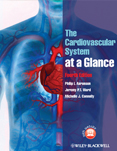- Home
- Cases
- Revision notes
- Your feedback
- Become a reviewer
- 'At a Glance' series
- More student books
- Student Apps
- Join an e-mail list


You are a foundation year house officer in geriatric medicine. One of your patients, a 98-year-old woman, was admitted from her nursing home with a cough productive of green sputum. She is currently being treated for community-acquired pneumonia with co-amoxiclav and clarithromycin. Three days later, she develops diarrhoea and on the consultant ward round, she complains of a ‘racing heart’. The consultant examines her and finds that her mucous membranes are dry and her pulse is 120 irregular. Auscultation of her chest reveals minimal crackles at the left base, and her heart sounds are normal. You ask one of the nurses to record an ECG. You review the ECG and note that the rhythm is irregularly irregular and that P waves are absent. You recall that her admission ECG showed normal sinus rhythm with old ischaemic changes (T wave inversion in V3–V6). You take blood and send it for a full blood count, urea and electrolytes, and C-reactive protein (CRP). You review the bloods and note that the white cell count and CRP are improving but the potassium is 3.0 (normal range 3.5–5.5 mmol/L).
1. What is the new ECG rhythm?
2. What is the likeliest cause of this woman’s arrhythmia?
3. Why has this woman developed diarrhoea?
4. How do you treat this patient?
See Chapters 48 and 51.